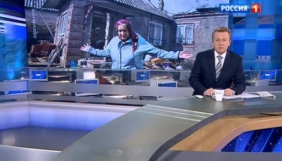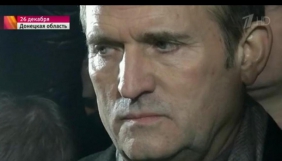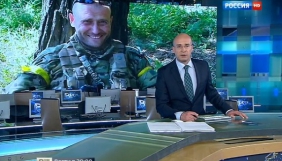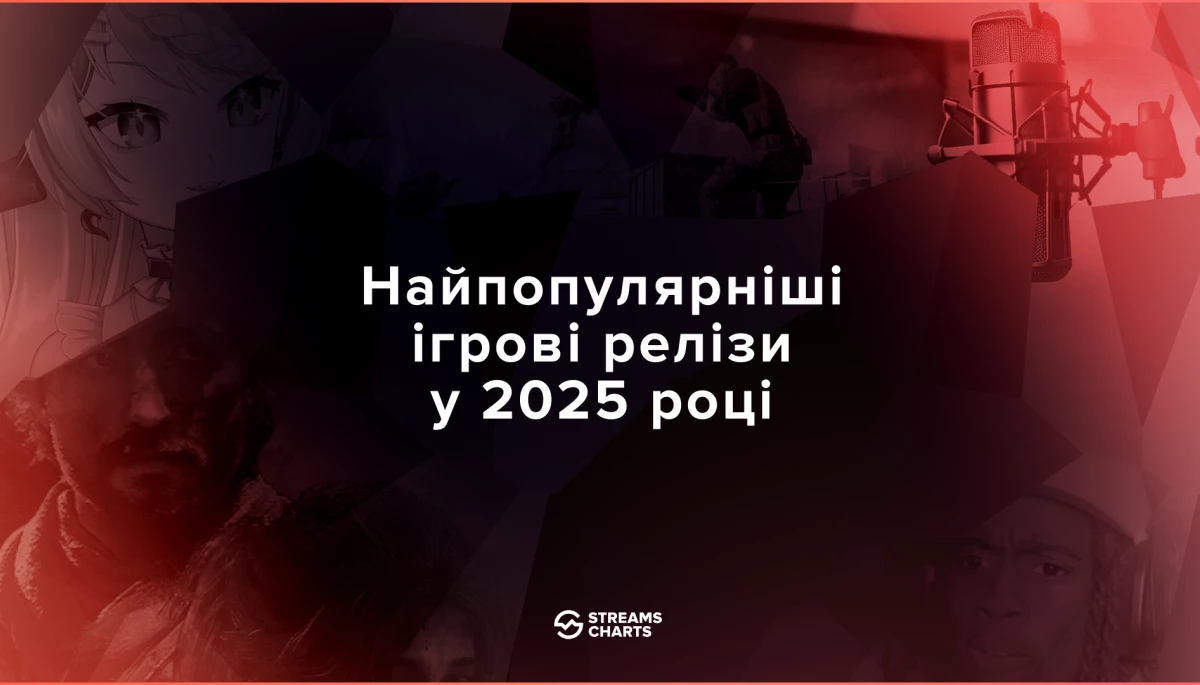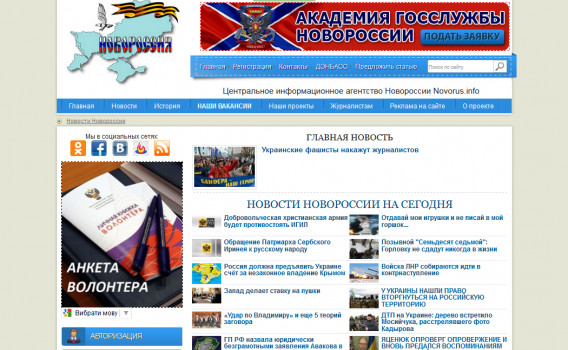
Виділіть її та натисніть Ctrl + Enter —
ми виправимo
Russian Propaganda in Ukrainian Information Space


There can be no doubt: this is not about single instances or short actions, this is about the long-term, premeditated, complex and consistent information-and-psychological operation aimed at incitement and justification of violence in the Eastern Ukraine.
During 2014, Telekritika, with USAID support provided via Internews Network, was monitoring the Russian media and the influence of Russian propaganda on Ukrainian information field. The consolidated report of Russian media monitoring results “Twilight of Russian Journalism. Propaganda-2014” has been published recently. All monitoring reports can be found in the “Russian Media” and “Propaganda and Influences” columns on MediaSapiens web-site.
Objectives of Propaganda at Different Stages of the Operation
A set of consecutive steps was undertaken to create the critical mass of people following separatist slogans, supporting ‘Novorossiya’ and even (together with Russian mercenaries and soldiers) taking active part in combat actions and terror; and propaganda had specific objectives at each of these steps.
1. Preparation: to create conditions for the fully-fledged information and real war. Disseminating the myths of ‘fraternal peoples’, Great ‘Victory’, cold war fears against the West, western values – all this has been ingrained by the soviet propaganda machine. After getting independent, especially since the mid 2000-ies, they were warmed up by the Russian propaganda (movies, books, agitation of Yanukovych) and have been lying like a time bomb waiting for a moment to detonate.
2. Creating the grounds for war. Maidan events should have become a ‘trigger’ of open conflict. Based on the already disseminated stereotypes and myths, the Russian propaganda distorted real causes and course of protests, demonized Maidan, attached negative labels and urged the Russian-speaking population of Ukraine to ‘defend itself’. This was accompanied by demonization of EU and NATO, discrediting EU-integration course, creating a range of mendacious myths about these international institutions (descending to homophobia and matching the EU with same-sex marriages, religion manipulations, etc.).

EU association means same-sex marriages.
Ukrainian Choice WARNS.
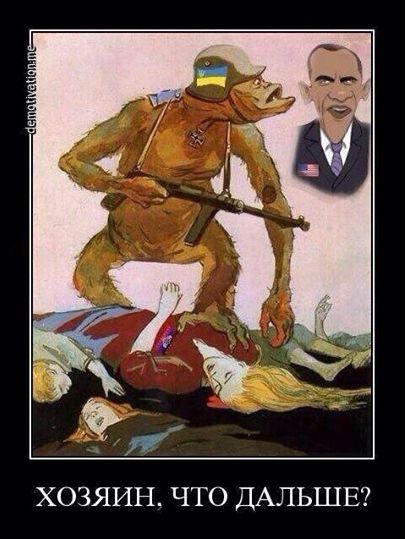
Master, what should I do next?
Russian propaganda uses old myths and stereotypes to discredit the Maidan events and EU-integration course (Photos are from open sources and social networks).
3. Making an enemy image of the new Kyiv authority is logical continuation of the steps described above. The Ukrainian government has become an enemy; and automatically the part of Ukrainian people that had managed to overthrow the Yanukovych regime became an enemy, and the whole Ukraine as a state is turned by the propaganda mirror into a hostile country. It is marked with all labels previously attached to Maidan activists (‘fascists – zombie – aggressors’), EU and NATO (‘bought by Americans – immoral – ungodly’).
4. Call for violence. This must by the most cynical page in the scenario when Russian propagandists turned from the dissemination of hatred and chauvinist hysteria to direct calls to kill Ukrainians. This was launched at the end of April, especially after the dramatic events in Odessa on 2 May.
This was implemented together with deployment of military campaign against Ukraine. The readiness of locals to violence or support of violence against the rest of Ukrainians was necessary to support the Russian military invasion and combat actions against Ukrainian army and volunteer battalions.
4. Legitimization of ‘LPR’ and ‘DPR’ as ‘states’. This was actively launched in June, and reached the surreal scale when we started talking not only about ‘ministers’ and ‘parliaments’ but also about ‘reforms’, ‘police’ and ‘nationalization’. ‘Well-being’ allegedly restored by ‘heads’ in these territories is contrasted with ‘total crisis and decay’ suffered by Ukrainians.
This was the evolution of propaganda that had ensured the readiness of society to bloodshed. During the whole war the propaganda keeps pursuing three important goals:
a) the responsibility for conflict is shifted to the shoulders of Kyiv. The Ukrainian Government is accused of ‘not hearing Donbas’ and taking political decisions against Donbas. So to speak, it is Kyiv who unleashed the war in spring and does not want to stop it right here and right now (despite the active calls of all pro-Russia agents in Ukraine). ‘Demonstration of kids’ in Sloviansk on 6 May and #SaveDonbassChildren campaign are the propaganda classics;
b) destabilizing of Ukrainian fore-front and home-front. This accompanies any war, it is the background of military propaganda. The first one is achieved by rumors about ‘right sector supporters’ shooting in the back of ‘politically unreliable’ soldiers; that ‘we are sold’, that the army has no legal grounds to take actions in Donbass and ‘this is not our war’. The second one is raised by cultivation of hatred against the out-migrants (numerous fakes spread in summer), imitation of ‘riot of mothers’, resentment over economic aftermath of war (and Kyiv is responsible for some reason), and stirring up hysteria because of blackouts in winter.

KIEV NEWS
Kyiv is Having a Rally against the War on 4 September

Varta1
Lviv News – Saturday, 28 June
Do refugees from the Eastern Ukraine abuse the hospitality of Lviv locals?
Lviv locals refuse to receive refugees from the Eastern Ukraine because of social network posts saying that the guests abuse the kindness of Galicia locals and try to defraud them.
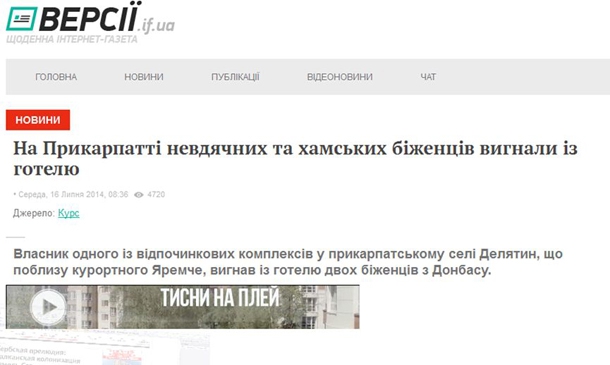
versii.if.ua
Internet Daily Newspaper of Ivano-Frankivsk
NEWS
Ungrateful and Caddish Refugees Driven Out from Hotel in Carpathian Region
An owner of one of recreation complexes in Carpathian village Deliatyn not far from Yaremche has driven out two Donbas refugees.
Destabilizing Ukrainian home front by means of Internet media.
Agents of Influence
Let’s define the terms. An agent of propaganda influence is not mandatorily a malicious enemy, a so called sellout ready to sell the Motherland and work for an occupant for a ‘pot of jam’. The propaganda influence may be transmitted by any person that spreads the information matching the propaganda. Why he or she does that – with evil intent or due to personal motives – does not matter. So we have no intent of labelling somebody or calling the patriotic community to shower stones: we are merely stating that some information activity worked in favor of Kremlin propagandists at some point.
It should be also noted: one does not need to retell tales about drugged/crucified boys or shot bullfinches to spread propaganda. One of our previous articles gives a detailed description of the Russian myth spread by Russian propaganda recent years (this year it was exceptionally active). This myth is complex and multibranch, all its components are interrelated. We can talk about historic memory and veterans, about the church and God, about civil protests in Vinnytsia or about Islamic fundamentalism in Turkey, but juggle in such way that it would be about the great Ancient Rus or bad Maidan. (The mentioned article even shows how the propaganda messages can be hidden in patriotic slogans and be spread devoutly by Ukrainian patriots.) Thus, the propaganda receives good opportunity to hide and disguise, and a researcher gets more difficult task: to distinguish propaganda in the overall discourse.
So, who was spreading Russian propaganda in Ukraine in 2014?
A. National Media
Unfortunately, monitoring by Telekritika detected traces of Russian propaganda in some national media. We have published materials proving the relation between the content of a range of Ukrainian press, radio and TV: ‘Komsomolskaya Pravda in Ukraine’, ‘Arguments and Facts. Ukraine’, ‘Channel 112’, ‘Vesti’ Holding and others. During the parliamentary election some of media (e.g. Inter TV-channel, Segodnia newspaper) were a media platform for Opposition Block that had evident pro-Russian rhetoric.
One should also bear in mind that a huge portion of broadcasting time of central TV-channels is taken by the Russian media product often bearing a charge of propaganda (in particular, MediaSapiens experts repeatedly reported about TV-series as a manipulation tool).
B. Social Networks
Social networks played the key role in incitement of hatred and escalation of violence during winter-spring 2014. At the very beginning of Russian operation (December 2013), there were created numerous groups dedicated to Antimaidan ideas in different formats in social networks (especially in VKontakte). At first, the majority of authors ‘were registered’ in Russian cities, in February-March there appeared many users from Crimea signifying the active recruitment of locals to information war on Russia’s side. Though, since March the number of members and contributors to groups increased thanks to the eastern and southern regions population being a logical consequence of tension escalation and involvement of more people in the conflict.
Social networks spread large volumes of untrue (fake) information: unverified ‘photo facts’, ‘videos of eyewitnesses’, ‘comments of participants’ etc. All in all, social networks spread the same myths and stereotypes as the Russian propaganda creates; they also foster anxiety, constant readiness to protective aggression.
C. Local Media
Local media in Luhansk, Donetsk, Odessa and Kharkiv oblasts played certain role in propaganda promotion at the initial stage of operation however the situation changed in autumn.
During the winter events in Kyiv and the start of war with Russia the majority of local media was trying to take a mild position. Thus, some Donetsk media called local pro-Russian gunmen as ‘militants’ and ‘pro-Russian activists’ and wrote ‘Donetsk People’s Republic’ in quotation marks (see ‘Druzhkovka Na Ladoniakh’ (Druzhkovka in Full View): page 4), ‘Vecherniy Donetsk’ (Evening Donetsk). Sometimes the same article featured the positive evaluation of actions of government as well as of separatists.
The logic is obvious: when the very society does not have any definite attitude to the possibility of forced integration with Russia, the local media are doing their best to be above the conflict so not to lose the audience. But another factor seems to be more substantial: the business and political elite having almost ultimate influence on the media discourse in the regions were hesitating and waiting which way the wind would blow. For example, in Donetsk region where those elite had taken their decision, the local media set immediately to propaganda of ‘radioactive ashes’ whereas Kharkiv region had opposite development (influenced by Avakov, Alasania, and after Dobkin’s oath of fealty to the new authority).
Some local media have taken the faithful pro-Ukrainian position straight away and denounced separatism. These are ‘IRTA’ Luhansk TV-channel, ‘Donbass’ and ‘Segodnia’ Donetsk newspapers, ‘Mediaport’ and ‘ATN’ Kharkiv newspapers, ‘Dumskaya.net’ from Odessa and others. One should also mention the local media controlled by NGOs and activists (‘Vostochnyi Variant’ (Eastern Variant) and ‘Politika 2.0’ in Luhansk, ‘Novosti Donbassa’ (Donbass News) in Donetsk) among these resources.
At the same time, other media controlled by pro-Russian businessmen and politicians (Lugansk LOT, ‘Skhid.Info’ (South.Info), ‘XXI Vek’ (20th century) and ‘0642’, ‘Zhizn’ (Life) newspaper of Donetsk oblast council and ‘Komitet’ (Committee) web-site, Odessa’s ‘Timer’) have expressed their positive support to the ideas of federalism and even separatism, denounced ‘war against own people’ and welcomed the actions of Russia. These media had most noticeable influence of myths and stereotypes spread by Russian propaganda.
Thus, the ‘XXI Vek’ newspaper (currently the main printed media of Luhansk terrorists) was actively publishing the calls of separatist leaders in April. ‘The alleged mass presence of Russians is – putting it lightly – unchecked information… Kyiv is doing its best to lose Donetsk… The more Kyiv calls the DPR representatives terrorists, the higher the chances are that they will go all the way… The protest itself has much in common with Maidan. The outfit of a Maidan self-defense representative and the one of DPR self-defense is camouflage, a bat, ski mask. Only the stripes are different,’ writes ‘Timer’ on 24 April. ‘Skhid.Info’ publishes the calls of separatists and gives instructions to participation in the May ‘referendum’.
The situation has turned in summer. The media doing their best to be good for everybody (Odessa’s ‘Glas’ (Voice) and ‘048’, Kharkiv’s ‘Status Kvo’ (Status Quo), ‘Severodonetskiy Khimik’ (Chemist of Severodonetsk) stopped flirting with ‘pro-Russian forces’ and took the part of Ukraine. The ones located in Donetsk, Luhansk and other already occupied territories (‘Union’, ‘IRTA’, ‘Realnaya Gazeta’ (Real Newspaper)) ceased regardless of their position. As of the end of 2014, only some of local media show the traces of Russian propaganda (for more details please see the article ‘Do Local Media Support Russian Propaganda?’)
During the first month of occupation the mass media in Crimea mainly tried to keep balance between pro-Russian and pro-Ukrainian discourse. But the lack of any signals and support from Kyiv left no alternative but to change their position in favor of Moscow. At the end of the year ‘Crimea. Comments’ and Tatar ’15 Minutes’ avoid any evaluations of political events; ‘Center of Journalist Investigations’ keeps pro-Ukrainian positions.
D. Information activity of local authorities and officials
Unfortunately, even local authorities may contribute to Russian propaganda. Such a regrettable activity was demonstrated by Donetsk Municipal Council (for example, the appeal of deputies of 8 May) and Luhansk Oblast Council (for example, the statement of the presidium of council of 5 May) as well as some city mayors and local councils in Donetsk and Luhansk oblasts this spring.
We relate this activity with the interest of local business in conflict escalation, their expectations to fish in troubled waters and flirt with terrorists. But in summer the war lords of gunmen took control over local affairs and local businessmen lost any influence on the processes in the territories controlled by terrorists so the majority of them left the region, and the local authorities went out of propaganda. However, the local authorities in occupied territories (e.g. Krasnyi Luch mayor) having joined the separatist and terrorist structures support propaganda line though within their communities only.
E. Political parties and some political leaders
Communist Party of Ukraine, Progressive Socialist Party of Ukraine, Rodina Party were active in pro-Russian information propagation in the southern and eastern regions. After the disturbances in Odessa and Kharkiv had been suppressed and after the Russian occupation of Donetsk and Luhansk, the parties made their information and propaganda activity latent (web-site, limited printed materials, occasional interviews to Russian TV-channels) with short comeback of CPU during the parliament election. The web-site of Nataliia Vitrenko calls ‘to stop the fratricidal war’, ‘to punish the murderers of children’ and to judge Yatsenyuk for genocide. CPU does not speak openly about the separation of territories but reproduces the Russian discourse in all other matters. Their information materials have plenty of aggressive language, the national authority is called ‘fascist’ and the anti-terrorist operation is 'fratricidal war’; Stalinism keeps being promoted.
The Party of Regions as a unified agent of information activity disappeared back in April, this was a logical result of internal disintegration of the party. At the same time, we notice the support of separatists by Oleg Tsariov, federalist position of Mykhailo Dobkin and Sergiy Tihipko’s call for decentralization of power.
The Opposition Block was founded for the parliament election; it has become a key agent of Russian propaganda in the election process. One of our previous reports gives details about the rhetoric of this political force so we will not repeat it here. We would like only to mention that their rhetoric is an interesting example of combination of formally patriotic slogans with the purposeful promotion of Kremlin propaganda.
The situation in Crimea is exceptional: the Ukrainian parties have practically ceased and are substituted with the Russian ones, in particular, ‘United Russia’ (Yedinaya Rossiya), ‘Spravedlivaya Rossiya’ (Just Russia), RF Communist Party.
F. Pro-Russian movements, organizations and terrorist groups
Pro-Russian and separatist organizations and groups are powerful agents of Russian propaganda at the local level.
Donetsk is covered by terrorist organization ‘Donetsk People’s Republic’ that claims to be a State formation and has its own media resources (‘First Republican’, DNR TV, ‘Central Information Agency of Novorossiya’, ‘Novorossiya’ newspaper etc.).
In Luhansk, at the beginning of war, ‘Luhansk Guard’ was the most active, it was hesitating from federalism to separatism ideas (obviously, depending on tactical objectives of its sponsors) but finally changed into ‘Luhansk People’s Republic’, another terrorist organization holding itself out as a State formation. Moreover, the oblast suffers from the activity of Cossack organizations beyond the control of ‘LPR’ as well as local terrorist groups (Kozitsyn’s group in the south, Driomov in Stakhanov-Pervomaisk, groups of Mozgovyi, Kosogor and others).
Odessa has got ‘Kulikovo Pole’ (Kulikovo Field), a relatively amorphous environment of different groups and organizations of Odessa performing independent information activity: from slogans about decentralization to openly anti-Ukrainian calls. The information is spread by groups ‘Odessa – Southern Front’, ‘Youth Unanimity’, ‘Odessa – Russia’, ‘Antimaidan’. After the tragic events of 2 May these groups significantly decreased their activity.
Kharkiv is characterized by active involvement of some local leaders of federalism movement (A. Gurianov, K. Dolgov, D. Levin, Yu. Opukhin). The information activity on behalf of organizations is seldom, though “Borotba” (Struggle) NGO, ‘Kharkiv People’s Republic’ emerge on the web from time to time but they do not enjoy any strong spread and influence.
G. Hearsay as a technology
Terrorist groups in Luhansk and Donetsk oblasts have an extensive network of agents among the locals to spread the rumors. The propaganda and meetings brought the high emotional tension, fear and protective aggression to the readiness to violence; and the disorientation, infoglut, fatigue of social earthquakes as well as threats contribute to spreading and believing in hearsays that would have been laughed at in peacetime.
H. Separatist media
This phenomenon was launched in spring and came to full flower in the middle of summer. Based in the seized editorial offices and studios, making use of TV-masts not destroyed by the Ukrainian government, with support of Russian pseudo-journalist fellows, the terrorists founded their own media: ‘XXI Vek’ and ‘Novorossiya’ newspapers, ‘Luhansk 24’, ‘First Republican’, ‘Novorossiya TV’ channels, ‘Radio Respublika’ etc. The evolution of these media is described in details in one of our previous reports; we would like only to say that since that publication the number of media has increased (especially, after the power supply was restored in Luhansk), and the tasks are still the same: to keep consistent and aggressive promotion of Russian propaganda, to form the hatred for Ukraine and to substantiate their right to control the occupied territories.
Evolution of Propaganda Discourse in Ukrainian Media
We do not mean and have no right to directly accuse any of Ukrainian media of conscious assistance to Russian aggressor. We have already said and would like to repeat again that media may spread propaganda inadvertently: just trying to take a friendly position to all parties to the conflict, to represent the alternative point of view etc. (Though the long monitoring of some media makes impression that Russian propaganda promotion makes part of their editorial line.)
Anyway, this year has experienced the change in style and form of Russian propaganda in Ukrainian media environment. This can be observed as in the case of “Komsomolskaya Pravda in Ukraine”.
This newspaper is a common example of a medium trying (at least on its face) to be ‘above’ the conflicts in Ukraine during this challenging year and not to stand up for either side. At first sight, one could hardly accuse the newspaper of support to Yanukovych regime and opposition to Maidan during the winter events. The periodical covered a lot the environment of protesters, the enthusiasm of citizens and wide support of the movement, wrote about the daily life of Maidan residents or certain people. Though they also wrote – with as much support – about the ‘Berkut’ but it was also ok: they are our fellows just on the other side…
For example, the 21 January issue where the paper makes the protesters responsible for violence escalation in Kyiv. ‘Ukraine experiences the clashes: protesters are bombing the ‘Berkut’ for last 24 hours. The latter responds,’ the newspaper says. ‘On Monday the protesters in Kyiv continued ‘making war’ against the enforcement bodies.’ Continued: “You say the ‘Berkut’ ran wild? But the protesters caused that: they are chopping the riot police like crazy. – ‘Get it, b*tch!’ shouts a maddened young man in black mask attacking the ‘Berkut’”. The news at the bottom of the same page says “radical youth organizations united to rebel. The movement Right Sector took openly the responsibility (!!! Roman Shutov) for Grushevskyi events.”
To sum up. Radical rough-necks, marchers attack, and the ‘Berkut’ is a victim. In order to deepen the impression, the newspaper gives an interview with a ‘Berkut’ soldier who allegedly suffered the ‘death corridor’ with tortures organized by protesters. And against this background – ‘Compromise is possible’ – is almost the direct speech of President Yanukovych (while the opposition ruined the negotiations). The issue is completed with a large article from the key ideologist of pro-Russian course Viktor Medvedchuk (it is his organization that placed light-boxes about single-sex marriages) praising the results of the Treaty of Pereyaslav of 1654 and saying openly that there is no other but pro-Russian course for the state.
The newspaper continues this line: the next day they publish an article justifying the ‘Berkut’ and saying that the unauthorized use of weapon is merely a chiller-dealer. And the column ‘Opinion from Moscow’ in the 4 February issue gives a frankly anti-maidan article describing ‘young people with masked faces that are ready to shatter, burn down and beat up’.
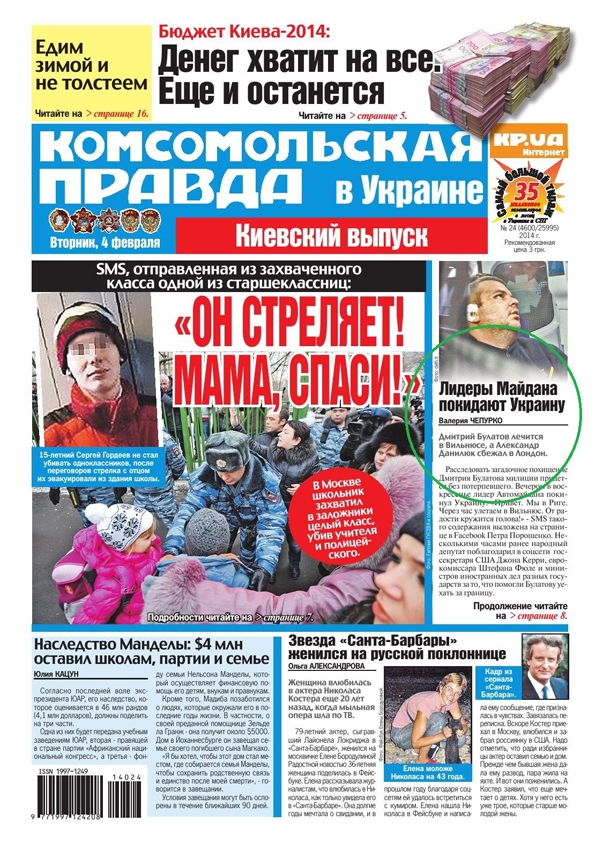
“Komsomolskaya Pravda in Ukraine” (Tuesday, 4 February):
Maidan Leaders Leaving Ukraine
By Valeriia Chepurko
Dmytro Bulatov treated in Vilnius, Oleksandr Danyliuk fled to London
On 4th February this could have been a sensation. But it was about Bulatov and Danyliuk indeed
By the way, speaking of ‘Berkut’. The attempts to glorify them under today’s date or post factum, the articles about ‘Berkut’ soldiers (standing, enduring, performing an order, and running away eventually, etc.) make feel sympathy for them, the heart-to-heart talks – all these was common to propaganda discourse both in Russian (social networks made the ‘Berkut’ soldiers real heroes in Russia) and Ukrainian media. “Komsomolskaya Pravda in Ukraine” writes a lot about the ‘Berkut’ in February.
The newspaper’s position about Crimea occupation is not clear. One can understand (at a stretch) their attempt ‘not to condemn’ the separatists but such phrases ‘newly-appointed by political meeting mayor of Sevastopol… Aleksei Chalyi has already taken his cabinet and started his work’ (26 February), this is undisguised legitimization of impostors and disrespect of Ukrainian laws.
This stand – ‘with sympathy’ to everyone and at the same time a little bit for the separatism – is characteristic of the newspaper on the ‘Donbas’ matter. Whereas the world media keep the rule not to give the floor to terrorists, the newspaper publishes an interview with Girkin (28 April).

“Komsomolskaya Pravda in Ukraine” (Monday, 28 April):
Head of Slaviansk Self-Defense Igor Strelkov:
The Majority of My Detachment Was in Chechnya and Central Asia
The 14 April issue has an almost absurd article about local elderly ladies from a boundary village having almost declared war against Kyiv, looking at coming troopers with hatred (with cross heading ‘They want to exterminate us’) and being heart and hand for separatists. One may laugh at it but it gives vivid images of ‘occupants’, ‘no one wanted you here’, and popular nature of anti-Ukrainian movement, even ‘politeness’ of Russians is played up (Russian border guards ‘made peace’ between these ladies and Ukrainian authorities). Citing one of these ladies the newspaper openly spreads the myths and lies of Russian propaganda without any comments: “…we hear from their deputies that we are ‘the beings deserving to die’”. And the key conclusion: Kyiv is responsible for the conflict in Eastern Ukraine: ‘I never wanted to go to Russia. But I have an impression that the new authority is pushing us there…’
And in the same column (a coincidence?) there is subtly a ‘point of view’ of Oksana Kaletnik with headline explaining the mentioned situation in serious terms: “Protesters in Donetsk: ‘We don’t want to Russia, we want to have the voice’”. It gives the parallels between the separatists and Maidan, and ‘double standards’ of the authority, and Kyiv’s mood “… to suppress and not to talk”. You may call it a coincidence but the newspaper is making the same picture as Russian media in broad brushstrokes.
The media trying to ‘be above the conflict’ used specific phrases: ‘militants’, ‘self-defense’, ‘pro-Russia activists’. We are not going deep into linguistic details but would like only to say that all these words legitimize those people, form defensive images and make impression of wide-spread nature of such phenomena. Eventually, these words vanished from the discourse: at first the word ‘self-defense’ disappeared from the columns (it has become obvious that it was not about any self-defense at all); then ‘militants’ (when the border was crossed by the shell-proof armor and MANPAD in one direction and KIA caravans in the other).
The words ‘terrorists’ and ‘separatists’ started being used more often. In particular, such evolution was noticed in summer on ‘112 Ukraine’ channel, and even the most brave separatist supporters (e.g. ‘Timer’ local medium of Odessa) started using the word ‘insurgent’ more and more often. ‘Komsomolskaya Pravda in Ukraine’ tries to avoid these terms calling the separatists “activists of ‘DPR’” and “’DPR’ supporters”.
As time went by, it was getting more difficult to keep the ‘polite face’ of separatism, the number of victims of terror became four-digit, the Russian propaganda has shown itself in more sophisticated forms: hiding behind the phrase ‘self-declared republic’ (but the republic anyway!, another solution was found ‘self-declared territories’. The latter one is absurd but there was no alternative to avoid ‘terrorists’), the generalized ‘south-east’ (supporting the spreading nature of the movement and latent conflict in other territories, for example, in Odessa), and behind the post factum discredit of Maidan as well as different fakes and artificial ‘newsbreaks’ to destabilize the home-front (see above). ‘Komsomolskaya Pravda in Ukraine’ does not publish any fakes, however, 23 June it almost justified a lady, MD from Kharkiv, who was kicking an injured Maidan protester, and pays respect to ‘riot of mothers’; the newspaper often uses the phrase ‘self-declared republics’.
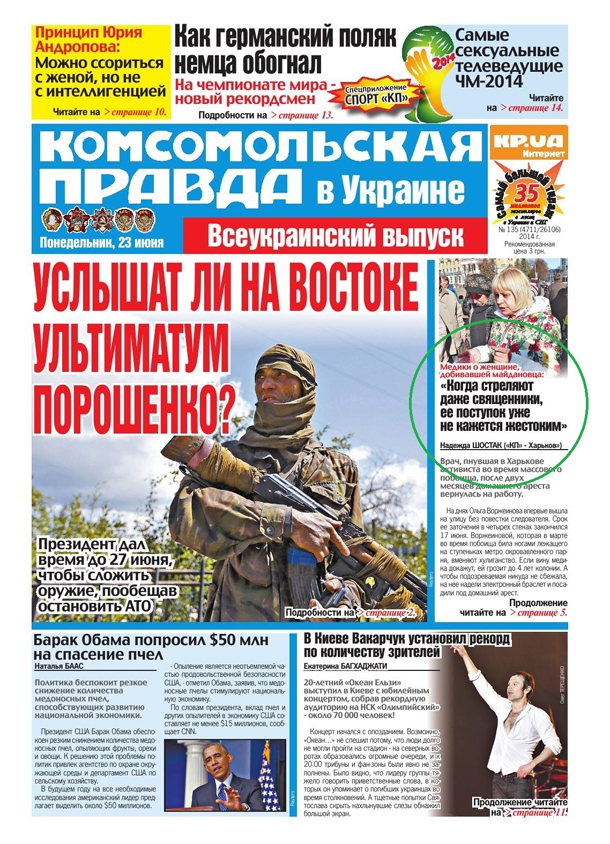
“Komsomolskaya Pravda in Ukraine” (Monday, 23 June):
Medical Workers about the Woman Smashing the Maidan Protester:
When Even the Priests Take Weapon Her Action Does Not Seem That Cruel
Headline of ‘Komsomolskaya Pravda in Ukraine’ of 23 June.
Another option: to describe people suffering from the war in territories controlled by terrorists. Firstly, from the war (that is from Ukrainian shelling), from non-payment of pensions, and then from lawlessness and anarchy. This method was noticed in ‘Vesti’ newspaper. During September the Ukrainian issues of KP had one piece about Mariupol shelling by separatists and eight pieces about sufferings of people because of Ukrainian forces’ attacks. ‘The firemen can’t get to help because of shelling… the pipeline is broken…” Citing a local: “Servicemen say they are shelled every day… It is horrible to wait for a ‘response’ every day. There is no hope for mercy” (15 September, page 3). And the issue of 22 September (page 4) has the material saying that ‘DPR’ actually helps out the citizens whom Ukraine left without any money.
The Russian propaganda wave stirred the Ukrainian media during the election of deputies, and took the form of agitation and jeansa from pro-Russian political forces. This wave affected the KP as well, but the newspaper allowed (by the way, this is also common) jeansa both from ‘oppositionists’ and from other political forces.
The war clears the air and it is getting more difficult to call black grey. By November it has become more difficult to find traces of Russian propaganda in “Komsomolskaya Pravda” and in the majority of Ukrainian media. But it is too early to say that they have abandoned the propaganda spread.
Ukraine’s Response
Against such a well-organized, consistent and premeditated information war, Ukraine turned out to be low-skilled and confused. It should be noted that neither patriotic forces of Maidan nor Ukrainian governments after the revolution deemed it necessary to explain their actions to the large public, first of all, to those who misunderstand them (who are told much lies). Maidan was too much occupied with its problems to agitate among the locals of the east and south; moreover, it was too amorphous to be efficient. This function could have been taken by the political parties who were actually involved in revolutionary events by making use of their organizational and technical resources. But at that time the parties were as pliant and confused as their leaders. Maidan was active in communication terms among its supporters but it did not communicate at all with potential opponents neither tried to explain to those who did not understand.
The same line was taken by the country leaders in the post-revolution period. Kyiv has never shown a clear strategy about Crimea and Donbas, never communicated any messages to the population of these territories. We are not going to exaggerate the meaning of phrases like ‘Crimea will be ours’ and ‘Donbas is and will be Ukrainian’: the Ukrainians in these territories did not want to hear that but specific instructions for action and explanations of the situation. Neither the leaders have explained the law on special status (eventually revoked) or the prohibition of financial transactions in the occupied territories, giving the propaganda the background for its own interpretation (and, of course, it took advantage of that). Thus, Kyiv has offered to the residents of occupied territories vague pieces of legislation, unjustified economic restrictions and a promise that ‘our children will go to school and theirs not’.
The government initiatives to limit the access of Ukrainian citizens to Russian media had no effect. Ukrainians have open access via the satellite; not all cable TV providers ceased broadcasting Russian TV-channels. Donetsk and Luhansk broadcast Russian TV-channels to frontline territories of Luhansk and Donetsk oblasts, and no one cares to suppress the signals. Some remote districts of Odessa oblast are not covered with Ukrainian TV instead the locals have access to the Russian one. The same situation is observed in some border districts of eastern oblasts. TV broadcasting in Crimea is not controlled by Ukrainian government at all. Ukrainians have free access to Russian segment of the Internet and Russian social networks.
The army makes no effort to explain its actions. Propaganda among the enemy’s frontline territories is one of the priorities in any war but it is not carried on at all: this is not a mere omission, this is a criminal omission. Lysychansk residents can tell you even now about the Ukrainian army destroying the local infrastructure: for example, it shelled the glass factory. We know that the terrorist stocks were stationed in the factory, but would the locals go deep into details when they saw tanks passing through their town? As sure as fate they will be telling this story to their children and grand-children, and we do not know what the results may be.
The information activity was nothing more than the leaflets with instructions what to do during artillery shelling. (Compare with the promo-campaign of Russian servicemen before Crimea annexation.) There are meetings of battalion chiefs and military commanders with locals but they are not regular.
Ukrainian media are hesitating from the position of ‘impartial mirror of truth’ (often hiding Russian propaganda behind as we have seen above) to spread of pro-Ukrainian propaganda. A good deal of room in the media environment is taken by our army, individual soldiers, heroic deed, volunteers, residents of occupied or liberated territories, out-migrants. All in all it is worth mentioning it is Ukrainian media that have ensured the stability of Ukrainian home-front, high spirit and patriotism in hard times. They are a kind of shield against Russian propaganda making fun of and exposing the lies of Russian channels.
Though the Ukrainian media confined themselves to the home-front having forgotten about people suffering in the occupied territories. They speak a lot about these people but not enough for them. In addition, the Ukrainian media were distorting the situation at the front in spring and summer (the ATO headquarters is the most responsible) and do not reflect the real picture in the Eastern Ukraine now (any out-migrant or soldier may prove that) so they are repulsed by the Donbas locals. The Ukrainian media actually keep silence about Crimea and if they say something this is with the view of propaganda for the most part (to show that everything is going bad there).
NGOs and social movements are trying hard to do something but their abilities are scarce. The initiatives like StopFake and ‘Ne Format” (Beyond Format) reveal the propaganda, and this influences the situation at the home-front but not in the occupied territories.
Is There Any Hope?
Ukraine is still able to collect its strength, restore the losses in information war and set about the struggle with Russian propaganda for thoughts and feelings of its citizens. We believe that the following points can be the first steps:
1. Ukrainian media must be as honest as possible. There are numerous discussions (and there are more to come) about possible risks and profit of such honesty, and in this discussion Telekritika is positive that the profit is much higher. The public awareness of real situation on the fronts will make the public pressure on the authorities to get things better and ensure the army’s efficiency. Disclosing of facts of violence of Ukrainian military men will stimulate to set up the army discipline control system, and the battalions have financial interest in their reputation since the maintenance and support by civil society depend on their good name. Understanding of peculiarities ‘from there’ will make the social integration of out-migrants and veterans easier.
The latest social researches prove that this line is correct: Ukrainian society is ready for the truth whatever it may be.
But the main point: the true coverage of Donbas reality will destroy the Russians’ myth that Ukrainian media lie and will restore the credit.
2. The State and Army must involve the civil society to communication with the residents of occupied territories. NGOs have enough expert and organizational resources to develop a strategy of such communication and even to implement it in the long-run (to develop and make TV and radio programs, print leaflets to be disseminated in occupied territories, use other alternative communication channels). The State has only to ensure the moral support, ‘green light’ and financial support.
3. Creating media content aimed at the audience of occupied territories. The media must first of all meet the information needs of population so they have to create the product satisfying the needs of people suffering in ATO zone and Crimea. Survival without water supply and sewage; treatment without drug stores nearby; what specific diseases threaten these people, prevention activities; what kind of help and how they can receive in liberated territories etc. – the affected people will consume this information from Ukrainian media and, eventually, return to the Ukrainian information and cultural space.
4. Launching the large discussion between media-experts, journalists, media-managers, and civil servants with view to make a joint vision and strategy of counteraction to Russian propaganda in Ukraine and consistently implement it with consolidated efforts.




